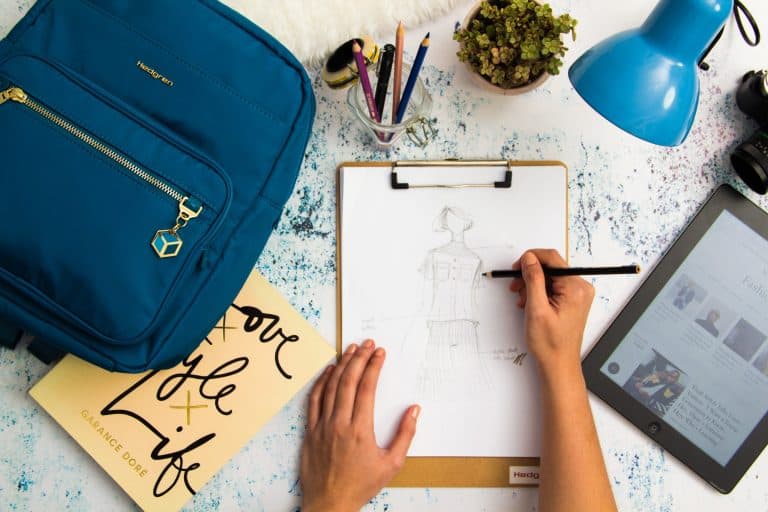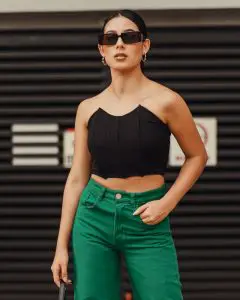Introduction
Predicting the future of fashion has never seemed so unattainable. How do fashion buyers seemingly look into a crystal ball and control the next seasons’ trends? How do they know what shoppers want before they do themselves? When the black leather blazer I wanted this season was sold out everywhere, I was done guessing. I took the liberty to research just how trend forecasters do it, so, whether you want to get a head start on building your wardrobe for the next season or constructing your brand’s new collection, you can do it too with these seven steps.
But first, what really is trend forecasting?
Fashion forecasting is the process of predicting trends that will generate consumer demand. With forecasting, a brand tries to fulfil a need in its customers’ closets that they didn’t know was there. A seasons’ colours, textures, and fabrics are usually determined months in advance with the help of trend forecasting tools. This process helps brands take the guesswork out of knowing what kind and how much product to purchase, as well as capitalizing on the market and advertising positioning by staying ahead of the curve. For personal use, trend forecasting can help you beat the crowds to items and be the one people ask, “Where did you get that”?
Now that you’ve got a sense of what fashion forecasting is and does, we can start looking at just how it’s done.
Here’s a quick breakdown of our article’s content to help you navigate it faster.
- Identify your customer base
- Determine what kind of forecasting you are interested in
- Conduct market research
- Utilise forecasting technology
- Stay caught up with fashion-focused magazines
- Actively follow influencers in social media
- Don’t lose sight of your own individuality
- Conclusions
1. Identify your customer base
The key to predicting your brand’s fashion trends is to know who you’re shopping for. Identifying your customer base will allow you to take into account their specific needs. It is important to identify your consumers’ gender, average age range, income, and lifestyle. A collection for a consumer base of 18-25 year old women will look very different than one for 45-60 year old men for obvious reasons, but these aspects will also affect the quality of the fabric, the price point, and the fit of items. Forecasting for a certain group will help narrow down product choices.
If you are trend forecasting for yourself, it also helps to identify what pieces will fit in with your own lifestyle and price point. How do you position yourself in the fashion market vs. where would you like to be positioned? For example, do you lead an active lifestyle and opt for a style that reflects that aspect, or do you consider yourself on the trendier side of the spectrum, always on the hunt for the perfect outfit for Instagram? By Identifying your own consumer base, you can look for brands that market to your lifestyle and needs.
2. Determine what kind of forecasting you are interested in
Forecasting can take on various time ranges.
- Short-term forecasting, also known as “seasonal” forecasting, predicts trends in the 6-12 month time span. In this range, we look predominately at colors, textures, and styles that are often influenced by current pop culture. Short-term forecasting also encompasses micro-forecasting, which deals with fleeting trends. A way to spot a fleeting trend is if it is a very exaggerated. For example, any items that are extremely tiny, neon colors, or large accessories.
- Long-term forecasting deals with predicting trends in the one-to-two-year time frame or longer. These trends will reflect bigger lifestyle changes in the consumer base at hand. From 2019 to 2020 and 2021, for example, fashion lines shifted focus from every day or business casual wear to a focus on lounge wear and clothes to be worn in the comfort of one’s home.
Fashion trends can also fall under two different categories in terms of life cycles – pendulum swings or fashion cycles.
- Pendulum swings are trends that go from one extreme to the next (think tight bodycon dresses to loose, shift dresses).
- Fashion cycles, on the other hand, are trends that lay dormant for a period of time but revive once again at a later date. This life cycle is what we have to thank for velour tracksuits making a comeback (or not).
3. Conduct market research
Once you’ve identified what type of trends your brand is interested in, an optional step would be to conduct market research. Using your ideal consumer base and your short or long term goals, it can be beneficial to reach out to consumers directly to find out the gaps in their needs and how you can fill them. This can be as easy as sending out a survey to those already subscribed to an email list. If you have the resources, holding a focus group will help dive into your customers’ needs on a deeper level. Showing a group of customers pictures of trends and receiving their feedback in real time is a very effective way to gain true insight on what they would like to receive from your next collection.
While the process isn’t exactly the same as conducting market research on a wide consumer base, a similar process can be done for personal reasons. Ask yourself what you feel may be missing in your closet. Figure out just what you feel would elevate your wardrobe, whether its basic items, statement pieces, or accessories. Once you’ve figured out your own unsatisfied needs, you can then further conduct your trend research to help fill these gaps.
4. Utilise forecasting technology
In today’s digital world, there is no shortage of forecasting technologies available on the internet. While some have hefty annual subscription fees, there are various ways to utilize these technologies for free as well.
Some of the paid sites you can subscribe to are WGSN by Ascential, Fossick Trends, or Trendstop. These websites, while pricey, are driven by science to predict not only trends in fashion, but all consumer and design trends, such as topics like interior design, food, technology, and even relationships. Looking at other industries that are not directly related to clothing can also prove useful to building a clothing line – if warm neutral tones are the colors of the next season for interior design, clothing lines will not be far off. If consumers are prioritizing self-care and comfort, their clothing styles will reflect the same ideologies. These websites will take much of the guesswork out of forecasting for an accurate product line and positive consumer behavior towards your brand.
Key information from these sites can be accessed for free, however. WGSN, Trendstop, and Fashion Snoops all have social media accounts you can follow for no charge at all. If you are trend forecasting for personal reasons, I would highly suggest following these accounts to stay ahead of the curve on upcoming fashion trends. These companies often post free seasonal reports as well that provide effective insights to upcoming trends.
5. Stay caught up with fashion-focused magazines
One of my favorite things to do in my spare time is read magazines’ online articles. Vogue, Elle, Marie Claire, Harper’s Bazaar, Allure and many other acclaimed magazines are excellent sources to find recaps of fashion weeks, articles on street style, and editorials on trends. All of these companies provide articles for free on their websites, which makes for an easily accessible, yet very effective method for tracking current and upcoming trends. Or, if you prefer a hard copy of their works, grabbing an issue of Vogue and sitting at your favorite coffee shop is a great way to spend an afternoon in Carrie Bradshaw style. Whichever way you prefer, magazines are a tried-and-true resource for trend forecasting information. By exposing yourself to different viewpoints of trends, you can create a well-rounded idea of what styles you would like your wardrobe or brand to reflect in the upcoming seasons.
6. Actively follow influencers on social media
While the word “influencer” is more of a recently coined term, these social media stars are more than an 18-year-old with a iPhone. They can be great sources for emerging trends on your Instagram, Twitter, or Tik Tok feed. Many influencers have brand deals with companies to promote their new lines, ensuring that their followers are exposed to new trends as soon as they are dropped. For personal use, these posts can be beneficial when looking for new trendy stores to shop and knowing exactly what outfit to piece together with their products.
As a company, forming deals with influencers is a great way to position your brand as a new hot commodity. Getting an influencer to wear your clothes can be as simple as sending them a free sample of items and encouraging them to tag your company if they wear it in a post. Building a relationship and trust with influencers will make it more likely that they will shed a positive light on your products, which will in turn create a demand for your product with their followers as well.
7. Don’t lose sight of your own individuality
As we have learned, fashion forecasting is a science and can be calculated using various technologies. But, once you have gathered your research about the next season’s forecast, it is vital to throw your own touch on the trends. Part of creating your own line is differentiating your products from other brands and generating consumer demand with a sense of individuality in your products. This can be done by adding accents on your pieces, adding your own take on a pattern, or even lowering your price point. Especially if you are a new brand, you already have the lower hand in comparison to an established company. The goal is to build a reputation with consumers that another company can’t replicate.
If you’re shopping for your own sake, finding pieces that aren’t quite like the ones that are flooding your social media feed will set you apart from others. Switching up an aspect of a popular item will effectively create that sense of individuality that we’re striving for. A way to inspire this uniqueness might be getting the same pair of sneakers that are “in”, but in an unexpected color. Simple changes are what will help you be perceived as a trendsetter and not a trend follower.
Conclusions
As we now know, fashion forecasting isn’t a fashion buyer with a crystal ball, but instead a calculated process that can be done by anyone. The goal of trend forecasting is to predict consumers’ needs before they recognize themselves, and by doing so, brands and individuals are able to act on trends before they emerge.
The first step in doing so is to figure out what consumer base you are forecasting for, following with identifying the goals of your forecast – are you looking for short-term or long-term trends? Next, you can conduct first-hand market research on your identified consumer base in order to learn which products’ trends should take precedent in your line or survey your own wardrobe to find out what pieces or styles are missing. At this point, it is beneficial to research on trend forecasting services to learn the upcoming trends for not only fashion, but other industries as well.
The outside environment is ever-changing, hand-in-hand with fashion trends. Whether or not you pay for these forecasting services, you can also stay up to date with informative fashion magazines for free online. Along with magazines, you can follow influencers on all social media platforms to sneak in extra interactive research while scrolling through your Instagram feed. Finally, even though you will be intaking various opinions on upcoming trends, don’t lose sight of your own individuality in the process. It is crucial to set yourself or your brand apart from the ideas that everyone else is trying to copy.
We hope you found this article useful to clarify some of the misconceptions surrounding fashion forecasting. If you’d like to read up more about this, look at the end of the post where we listed some additional articles from our blog that can help you go one step further into the world of retail and merchandise.







